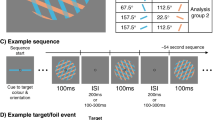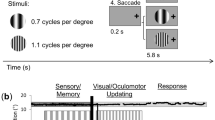Abstract
Observers viewing a complex visual scene selectively attend to relevant locations or objects and ignore irrelevant ones. Selective attention to an object enhances its neural representation in extrastriate cortex, compared with those of unattended objects, via top-down attentional control signals. The posterior parietal cortex is centrally involved in this control of spatial attention. We examined brain activity during attention shifts using rapid, event-related fMRI of human observers as they covertly shifted attention between two peripheral spatial locations. Activation in extrastriate cortex increased after a shift of attention to the contralateral visual field and remained high during sustained contralateral attention. The time course of activity was substantially different in posterior parietal cortex, where transient increases in activation accompanied shifts of attention in either direction. This result suggests that activation of the parietal cortex is associated with a discrete signal to shift spatial attention, and is not the source of a signal to continuously maintain the current attentive state.
This is a preview of subscription content, access via your institution
Access options
Subscribe to this journal
Receive 12 print issues and online access
$209.00 per year
only $17.42 per issue
Buy this article
- Purchase on Springer Link
- Instant access to full article PDF
Prices may be subject to local taxes which are calculated during checkout







Similar content being viewed by others
References
Desimone, R. & Duncan, J. Neural mechanisms of selective visual attention. Ann. Rev. Neurosci. 18, 193–222 (1995).
Yantis, S. in Attention (ed. Pashler, H.) 223–256 (Psychology Press, East Sussex, UK, 1998).
Kastner, S. & Ungerleider, L.G. Mechanisms of visual attention in the human cortex. Ann. Rev. Neurosci. 23, 315–341 (2000).
Kanwisher, N. & Wojciulik, E. Visual attention: insights from brain imaging. Nat. Rev. Neurosci. 1, 91–100 (2000).
Corbetta, M. & Shulman, G.L. Control of goal-directed and stimulus-driven attention in the brain. Nat. Rev. Neurosci. 3, 215–229 (2002).
Moran, J. & Desimone, R. Selective attention gates visual processing in the extrastriate cortex. Science 229, 782–784 (1985).
Reynolds, J.H., Chelazzi, L. & Desimone, R. Competitive mechanisms subserve attention in macaque areas V2 and V4. J. Neurosci. 19, 1736–1753 (1999).
Kastner, S., De Weerd, P., Desimone, R. & Ungerleider, L.G. Mechanisms of directed attention in the human extrastriate cortex as revealed by functional MRI. Science 282, 108–111 (1998).
Motter, B.C. Focal attention produces spatially selective processing in visual cortical areas V1, V2 and V4 in the presence of competing stimuli. J. Neurophysiol. 70, 909–919 (1993).
Motter, B.C. Neural correlates of feature selective memory and pop-out in extrastriate area V4. J. Neurosci. 14, 2190–2199 (1994).
Treue, S. & Maunsell, J.H.R. Attentional modulation of visual motion processing in cortical areas MT and MST. Nature 382, 539–541 (1996).
Connor, C.E., Preddie, D.C., Gallant, J.L. & Van Essen, D.C. Spatial attention effects in macaque area V4. J. Neurosci. 17, 3201–3214 (1997).
Corbetta, M., Miezin, F.M., Dobmeyer, S., Shulman, G.L. & Petersen, S.E. Attentional modulation of neural processing of shape, color and velocity in humans. Science 248, 1556–1559 (1990).
Heinze, H.J. et al. Combined spatial and temporal imaging of brain activity during visual selective attention in humans. Nature 372, 543–546 (1994).
O'Craven, K.M., Rosen, B.R., Kwong, K.K., Treisman, A. & Savoy, R.L. Voluntary attention modulates fMRI activity in human MT-MST. Neuron 18, 591–598 (1997).
Tootell, R.B.H. et al. The retinotopy of visual spatial attention. Neuron 21, 1409–1422 (1998).
Gandhi, S.P., Heeger, D.J. & Boynton, G.M. Spatial attention affects brain activity in human primary visual cortex. Proc. Natl. Acad. Sci. USA 96, 3314–3319 (1999).
Brefczynski, J.A. & DeYoe, E.A. A physiological correlate of the “spotlight” of visual attention. Nat. Neurosci. 2, 370–374 (1999).
Bushnell, M.C., Goldberg, M.E. & Robinson, D.L. Behavioral enhancement of visual responses in monkey cerebral cortex. J. Neurophysiol. 46, 755–772 (1981).
Colby, C.L., Duhamel, J.R. & Goldberg, M.E. Visual, presaccadic, and cognitive activation of single neurons in monkey lateral intraparietal area. J. Neurophysiol. 76, 2841–2852 (1996).
Constantinidis, C. & Steinmetz, M.A. Neuronal activity in posterior parietal area 7a during the delay periods of a spatial memory task. J. Neurophysiol. 76, 1352–1355 (1996).
Constantinidis, C. & Steinmetz, M.A. Neuronal responses in area 7a to multiple-stimulus displays: I. Neurons encode the location of the salient stimulus. Cereb. Cortex 11, 581–591 (2001).
Constantinidis, C. & Steinmetz, M.A. Neuronal responses in area 7a to multiple-stimulus displays: II. Responses are suppressed at the cued location. Cereb. Cortex 11, 592–597 (2001).
Mesulam, M.M. A cortical network for directed attention and unilateral neglect. Ann. Neurol. 10, 309–325 (1981).
Posner, M.I., Walker, J.A., Friedrich, F.J. & Rafal, R.D. Effects of parietal injury on covert orienting of attention. J. Neurosci. 4, 1863–1874 (1984).
Corbetta, M., Miezin, F.M., Shulman, G.L., & Petersen, S.E. A PET study of visuospatial attention. J. Neurosci. 13, 1202–1226 (1993).
Nobre, A.C. et al. Functional localization of the system for visuospatial attention using positron emission tomography. Brain 120, 515–533 (1997).
Culham, J.C. et al. Cortical fMRI activation produced by attentive tracking of moving targets. J. Neurophysiol. 80, 2657–2670 (1998).
Coull, J.T. & Nobre, A.C. Where and when to pay attention: the neural systems for directing attention to spatial locations and to time intervals as revealed by both PET and fMRI. J. Neurosci. 18, 7426–7435 (1998).
Wojciulik, E. & Kanwisher, N. The generality of parietal involvement in visual attention. Neuron 23, 747–764 (1999).
Hopfinger, J.B., Buonocore, M.H. & Mangun, G.R. The neural mechanisms of top-down attentional control. Nat. Neurosci. 3, 284–291 (2000).
Corbetta, M., Kincade, J.M., Ollinger, J.M., McAvoy, M.P. & Shulman, G.L. Voluntary orienting is dissociated from target detection in human posterior parietal cortex. Nat. Neurosci. 3, 292–297 (2000).
Rushworth, M.F.S., Paus, T. & Sipila, P.K. Attention systems and the organization of the human parietal cortex. J. Neurosci. 21, 5262–5271 (2001).
Petersen, S., Robinson, D.L. & Morris, J.D. Contributions of the pulvinar to visual spatial attention. Neuropsychologia 25, 97–105 (1987).
Desimone, R., Wessinger, M., Thomas, L. & Schneider, W. Attentional control of visual perception: cortical and subcortical mechanisms. Cold Spr. Harb. Symp. Quant. Biol. 55, 963–971 (1990).
LaBerge, D. & Buchsbaum, M.S. Positron emission tomographic measurements of pulvinar activity during an attention task. J. Neurosci. 10, 613–619 (1990).
Olshausen, B.A., Anderson, C.H. & Van Essen, D.C. A neurobiological model of visual attention and invariant pattern recognition based on dynamic routing of information. J. Neurosci. 13, 4700–4719 (1993).
Goebel, R. in Advances in Neural Information Processing Systems 5 (eds. Giles, C. L., Hanson, S. J. & Cowan, J. D.) 903–910 (Morgan Kaufmann, San Mateo, California, 1993).
Sperling, G. & Reeves, A. in Attention and Performance VIII (ed. Nickerson, R.S.) 347–360 (Erlbaum, Hillsdale, NJ, 1980).
Reeves, A. & Sperling, G. Attention gating in short-term visual memory. Psych. Rev. 93, 180–206 (1986).
Snyder, L.H., Batista, A.P. & Andersen, R.A. Coding of intention in the posterior parietal cortex. Nature 386, 167–170 (1997).
Burock, M.A., Buckner, R.L., Woldorff, M.G., Rosen, B.R. & Dale, A.M. Randomized event-related experimental designs allow for extremely rapid presentation rates using functional MRI. Neuroreport 9, 3735–3739 (1998).
Miezin, F.M., Maccotta, L., Ollinger, J.M., Petersen, S.E. & Buckner, R.L. Characterizing the hemodynamic response: effects of presentation rate, sampling procedure, and the possibility of ordering brain activity based on relative timing. Neuroimage 11, 735–759 (2000).
Corbetta, M. et al. A common network of functional areas for attention and eye movements. Neuron 21, 761–773 (1998).
Boynton, G.M., Engel, S.A., Glover, G.H. & Heeger, D.J. Linear systems analysis of functional magnetic resonance imaging in human V1. J. Neurosci. 16, 4207–4221 (1996).
Talairach, J. & Tournoux, P. Co-planar Stereotaxic Atlas of the Human Brain (Thieme, New York, 1988).
Acknowledgements
We thank T. Brawner, J. Gillen and X. Golay for technical assistance and V. Lamme, J.B. Sala, and S. Slotnick for valuable suggestions. This study was supported by grants from the National Institute on Drug Abuse (R01-DA13165) to S.Y. and from the National Center for Research Resources, NIH (P41-RR15241) to the F.M. Kirby Research Center for Functional Brain Imaging (Kennedy Krieger Institute) in Baltimore. J.S. was supported by the German Academic Exchange Service, J.T.S. was supported by the National Eye Institute and the National Science Foundation, and R.L.C. was supported by the National Institute of Mental Health.
Author information
Authors and Affiliations
Corresponding author
Ethics declarations
Competing interests
The authors declare no competing financial interests.
Supplementary information
Rights and permissions
About this article
Cite this article
Yantis, S., Schwarzbach, J., Serences, J. et al. Transient neural activity in human parietal cortex during spatial attention shifts. Nat Neurosci 5, 995–1002 (2002). https://doi.org/10.1038/nn921
Received:
Accepted:
Published:
Issue Date:
DOI: https://doi.org/10.1038/nn921
This article is cited by
-
Orthogonal neural encoding of targets and distractors supports multivariate cognitive control
Nature Human Behaviour (2024)
-
Within-subject reproducibility varies in multi-modal, longitudinal brain networks
Scientific Reports (2023)
-
Occipital and parietal cortex participate in a cortical network for transsaccadic discrimination of object shape and orientation
Scientific Reports (2023)
-
Neural Modeling and Real-Time Environment Training of Human Binocular Stereo Visual Tracking
Cognitive Computation (2023)
-
Investigation of baseline attention, executive control, and performance variability in female varsity athletes
Brain Imaging and Behavior (2022)



